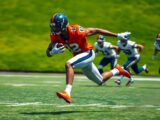
QB Drills to Improve Decision-Making Under Pressure
January 24, 2025To improve your decision-making under pressure, focus on targeted QB drills. Incorporate 7-on-7 simulations to replicate game conditions, enhancing your assessment skills and quick reactions. The Sudden Change QB Drill can sharpen your footwork and speed, while the Brady Quarterback Drill helps with pocket movement and target identification. Engage in mental preparation techniques, like visualization, to boost your confidence. Don't overlook endurance training, as it improves reaction times and helps you maintain composure. Consistent practice of these strategies can lead to significant improvements in your gameplay. There's much more to explore about optimizing your performance in critical moments.
Importance of Decision-Making
In the fast-paced world of football, decision-making stands as a cornerstone of a quarterback's success. Your ability to quickly assess the field and make smart choices under pressure can be the difference between a game-winning drive and a costly turnover. When you're poised and composed, you can effectively evaluate your options, ensuring that you keep your focus on the field, even in high-stress situations.
Incorporating agility training techniques can also enhance your ability to evade defenders while making decisions on the fly. Developing strong decision-making skills reduces the chances of forcing throws into tight coverage, which often leads to interceptions and stalled offensive drives. Instead, you'll be able to scan the field efficiently, recognizing opportunities as they arise. Additionally, consistent effort is crucial for refining skills and decision-making in real-time scenarios.
By participating in drills that simulate game conditions, you'll build confidence and improve your reaction times, allowing you to respond effectively during critical moments. Analyzing game film also plays a significant role in sharpening your decision-making abilities. Understanding previous plays and outcomes enhances your capacity to make informed choices during the game. Additionally, practicing effective communication helps in maintaining team coordination and elevating overall performance.
Ultimately, honing these skills is essential for any quarterback aiming for success, as the ability to make quick, smart decisions can lead to impressive plays and victory on the field.
Common Decision-Making Mistakes
When you're on the field, poor decision-making can cost your team dearly. Forcing tight throws, delaying your ball release, and making inaccurate pass decisions can lead to turnovers and stalled drives. Incorporating agility training into your routine can also enhance your ability to quickly assess situations and make better decisions. Proper stretching techniques can improve your flexibility and readiness, contributing to a more confident performance under pressure.
Let's break down these common mistakes and how to avoid them. Effective endurance training methods can enhance your physical readiness, enabling quicker and more confident decision-making under pressure.
Forcing Tight Throws
Forcing tight throws into coverage can be one of the most detrimental mistakes a quarterback makes. Nearly 50% of passes thrown into tight windows lead to turnovers, so it's essential to recognize when to take safer options.
Holding onto the ball too long while contemplating a tight throw can also increase your risk of being sacked, as quick decision-making is imperative under pressure.
Here are three key points to reflect on:
- Abandon Tight Throws: Studies show that over 70% of successful quarterbacks opt to throw it away or check down under pressure, avoiding potential turnovers.
- Recognize Defensive Pressure: In high-pressure situations, completing less than 60% of your passes often stalls offensive drives, making it important to assess your throwing mechanics quickly.
- Avoid Negative Yardage: More than 30% of unsuccessful pass attempts result in significant yard losses, directly impacting your team's performance.
Incorporating specific quarterback drills can sharpen your ability to make quick decisions and improve your overall throwing mechanics, ensuring you don't fall into the trap of forcing tight throws.
Delayed Ball Release
Delayed ball release is a common mistake that can sabotage a quarterback's performance. When you hesitate to throw due to uncertainty about the defense's coverage or your receiver's separation, you're risking missed opportunities.
Holding onto the ball too long not only increases your chances of getting sacked but also allows defenders to close in, making quick decision-making essential.
Statistically, quarterbacks who release the ball within 2.5 seconds have a considerably lower chance of being sacked compared to those who take longer. This highlights the importance of honing your ability to make quick decisions.
Delaying your throw can lead to hurried passes that often compromise your throwing accuracy, resulting in inaccurate throws that could have been avoided.
To combat this, practice quick decision-making drills that simulate game situations. These exercises will help reduce your average release time and build your confidence under pressure.
Inaccurate Pass Decisions
In the heat of the moment, making inaccurate pass decisions can be a game-changer. As a quarterback, your ability to read the field and make quick, informed choices is vital. Rushed decisions often lead to poor mechanics, resulting in inaccurate throws that can stall your offensive drive.
Here are three common mistakes you should avoid:
- Forcing throws into tight coverage: Nearly 50% of interceptions occur when quarterbacks make this mistake, especially under pressure.
- Holding onto the ball too long: Taking longer than 3 seconds to throw increases the risk of being sacked over 30% of the time.
- Delayed decision-making: Holding the ball for over 4 seconds averages 2.5 sacks per game, leading to negative yardage plays.
Improving your decision-making skills is essential for your success on the field. Remember, accurate throws come from confident, quick decisions.
Focus on reading the defense and trust your instincts to avoid costly turnovers, as quarterbacks with lower decision-making skills average 1.5 turnovers per game.
Make every throw count!
Strategies for Improvement
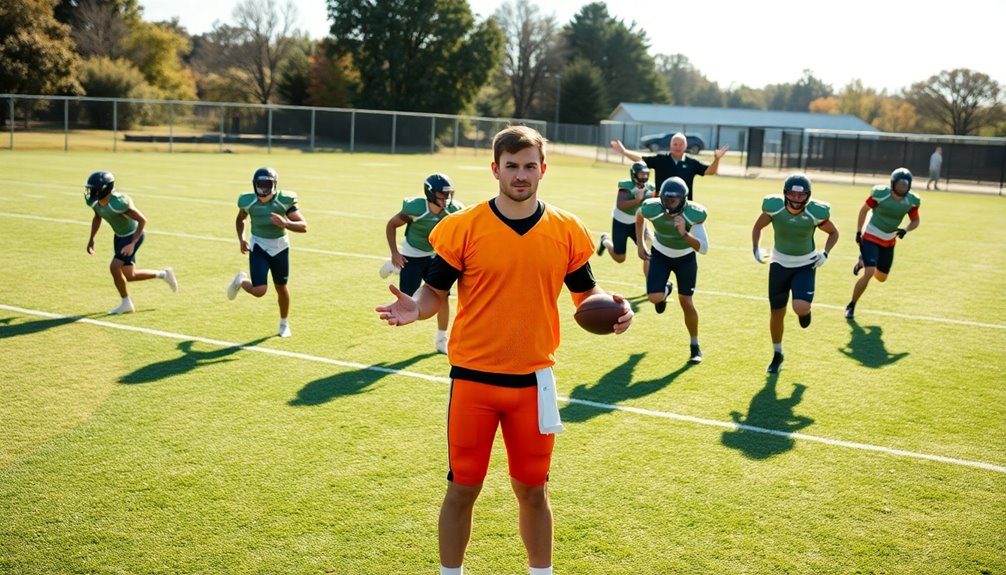
To improve your decision-making skills, you should focus on quick decision-making drills that mimic game situations. Incorporating high-pressure scenarios into your practice can sharpen your instincts when the heat's on. Additionally, analyzing game film helps you pinpoint areas for growth and reinforces effective decision-making strategies. Regular practice with teammates to build chemistry can further enhance your ability to make swift decisions during competitive play. Furthermore, engaging in communication on the field fosters better understanding and execution of passing strategies under pressure. Adding pain shuttles drills to your regimen can also help enhance your endurance and speed, allowing for quicker decision-making during intense moments in a game.
#
Quick Decision-Making Drills
Enhancing quick decision-making skills is essential for any quarterback looking to thrive under pressure. To improve your ability to assess situations and make rapid choices, incorporate these quick decision-making drills into your practice routine:
- 7-on-7 Drills: Engage in these drills to simulate real-game dynamics. You'll need to quickly identify open receivers while facing defensive pressure, honing your decision-making speed.
- Field Scanning and Route Recognition: Practice drills that enhance your ability to read the field effectively. Prioritize receivers based on their routes and the defensive coverage you face, allowing you to make swift and accurate decisions.
- Mental Preparation: Utilize visualization techniques to calm your mind under stress. By mentally rehearsing game situations, you'll enhance your ability to make better choices when it counts.
Additionally, regularly analyze game film to learn from your past mistakes. This reflection helps refine your decision-making skills by recognizing patterns and adjusting your strategies accordingly.
High-Pressure Scenario Practices
High-pressure scenario practices are essential for developing a quarterback's ability to perform under stress. To simulate game-time pressure, incorporate 7-on-7 drills that allow you to practice quick decision-making while facing defenders. These scenarios help you adapt to the intensity of actual games.
Utilize timed drills where you must make rapid choices under simulated defensive rushes. These drills to improve your decision-making skills create an environment that mirrors real-game situations, pushing you to think on your feet.
Develop mental preparation techniques, such as visualization, to promote calmness and clarity during high-stress moments on the field. This mental training can be just as vital as physical drills.
Additionally, implement quick decision-making drills that require you to assess multiple receiver options and execute throws in a limited timeframe. These practices sharpen your ability to make the right calls when the pressure mounts.
Game Film Analysis Techniques
How can game film analysis elevate your decision-making on the field? By reviewing your past performances, you can pinpoint how you responded under pressure, leading to improved decision-making in future games.
Here are three effective techniques to enhance your analysis:
- Focus on Key Situations: Identify specific plays where quick decisions were essential. Analyze the outcomes to understand what worked and what didn't, allowing you to refine your approach in similar scenarios.
- Timing and Reaction: Look closely at how your decisions aligned with the defensive rush and receiver routes. This will help you spot patterns and areas where you can improve your processing speed and reaction time.
- Utilize Software Tools: Take advantage of frame-by-frame analysis tools to dissect your footwork, body positioning, and decision-making processes during critical moments. This detailed breakdown can reveal subtle improvements that can make a significant difference under pressure.
Engaging with coaches to discuss these insights will deepen your understanding of situational awareness, further enhancing your decision-making skills on the field.
Embrace game film analysis as an essential tool for your growth as a quarterback.
## Quick Decision-Making Drills
Quick decision-making drills are vital for quarterbacks aiming to excel in dynamic game situations. These drills enhance your ability to assess field conditions and make accurate choices under pressure, which is essential for your success on the field.
One effective drill is the Sudden Change QB Drill. This exercise emphasizes rapid reactions and footwork adjustments while keeping your focus downfield. By practicing this drill, you'll improve your decision-making speed considerably.
Incorporating 7-on-7 football drills can also simulate real-game scenarios, allowing you to practice quick reads and timing with your receivers. These drills give you the experience needed to make swift decisions when the game is on the line. Notably, the Costa Rica national team has demonstrated the importance of team dynamics in achieving success through strategic collaboration.
Additionally, mental preparation techniques like visualization can promote calmness, further enhancing your quick decision-making abilities during high-stress situations. By mentally rehearsing plays and scenarios, you'll be better equipped to handle unexpected challenges that arise during a game.
Furthermore, understanding the history of soccer can provide valuable insights into teamwork and strategy that can be applied to football.
Ultimately, by consistently engaging in quick decision-making drills, you'll sharpen your skills and become more effective at making the right choices, even under the most intense pressure.
7-on-7 Game Simulations
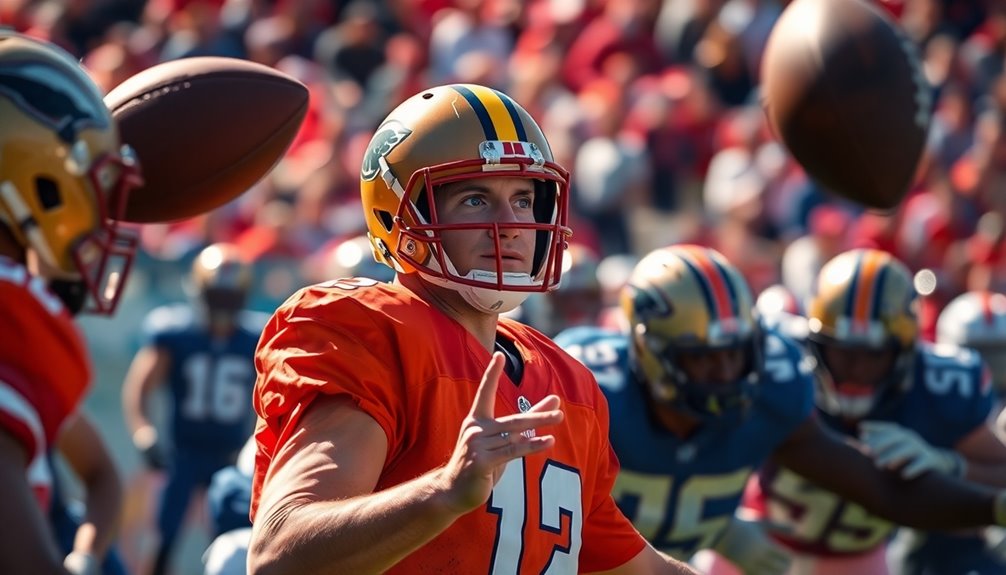
In 7-on-7 game simulations, you get to experience realistic game situations that sharpen your decision-making skills. These drills enhance your ability to think quickly under pressure while also building chemistry with your teammates. Understanding essential skills and positions can further improve your performance during these simulations. Additionally, effective communication among players, similar to the defensive line organization in soccer, is crucial for executing plays successfully. Incorporating teamwork enhancement exercises into these simulations can further elevate your coordination and collective effectiveness on the field.
Realistic Game Situations
7-on-7 game simulations are an indispensable tool for quarterbacks to sharpen their decision-making skills in a realistic setting.
By facing live defenders, you can enhance your ability to read defenses and execute quick throws under pressure. These simulations expose you to various pass routes, demanding that you rapidly assess which receiver is open based on the defense's alignment and movements.
Here are three key benefits of 7-on-7 game simulations:
- Situational Awareness: Incorporating drills like two-minute or red zone situations helps you practice making critical decisions in high-stakes scenarios.
- Adaptability: Facing a mix of coverages and blitz packages improves your reaction time, preparing you for unexpected defensive strategies during real games.
- Team Chemistry: Regular participation in 7-on-7s fosters a better connection with your receivers, which is essential for executing plays effectively.
Enhancing Quick Decision-Making
Game simulations provide a perfect environment for quarterbacks to enhance their quick decision-making skills. In 7-on-7 game simulations, you'll encounter high-pressure scenarios that mimic real game situations, allowing you to practice making rapid decisions.
With fewer players on the field, you can focus more on reading defenses and recognizing open receivers while under simulated pressure.
By incorporating specific route concepts during these drills, you'll sharpen your ability to anticipate receiver movements, which is vital for quick decision-making. Practicing in this dynamic environment refines your field scanning skills, helping you identify target opportunities swiftly, even when defensive pressure mounts.
Regular participation in 7-on-7 simulations can greatly decrease your reaction times and boost your confidence in decision-making when it really counts.
As you navigate these fast-paced drills, you'll find yourself making smarter choices and executing plays more effectively.
Ultimately, these simulations help prepare you for the intense situations quarterbacks face during actual games, ensuring you're ready to make the right call in the blink of an eye.
Embrace these drills, and watch your decision-making prowess soar!
Building Team Chemistry
Effective team chemistry is essential for a quarterback's success, and on-field practice through 7-on-7 simulations plays a key role in building that bond. These drills create a controlled environment where you can sharpen your decision-making skills while mimicking actual game scenarios.
Here's how you can enhance team chemistry through these simulations:
- Communication: Regular interactions during 7-on-7 drills promote open lines of communication between you and your receivers, allowing for quicker adjustments mid-play.
- Familiarity with Playing Styles: As you work together, you'll become more attuned to each receiver's preferred routes and timing, which leads to improved offensive execution.
- Cognitive Adaptability: Facing various defensive alignments challenges you to adapt your decision-making, helping you think on your feet and make better choices under pressure.
Mental Preparation Techniques
Mental preparation techniques are essential for a quarterback's success on the field. By incorporating visualization techniques, you can mentally rehearse successful plays and outcomes before facing actual game scenarios. This practice boosts your confidence and sharpens your focus, critical for effective decision-making under pressure.
Additionally, practicing mindfulness and breathing exercises can greatly reduce anxiety, helping you maintain composure in high-stress situations. Staying calm allows for clearer decision-making, even when the game gets intense.
Incorporating situational drills that simulate high-pressure game scenarios can also enhance your ability to make quick, effective decisions. These drills prepare you for real game situations, ensuring you're ready when the moment counts.
Don't forget to develop a routine that includes mental conditioning exercises like cognitive drills or reaction time games. These activities strengthen your mental agility and adaptability, which are essential when dealing with unexpected challenges on the field. Moreover, focusing on mental strength can significantly improve your ability to handle pressure and enhance your overall performance.
Analyzing Game Film
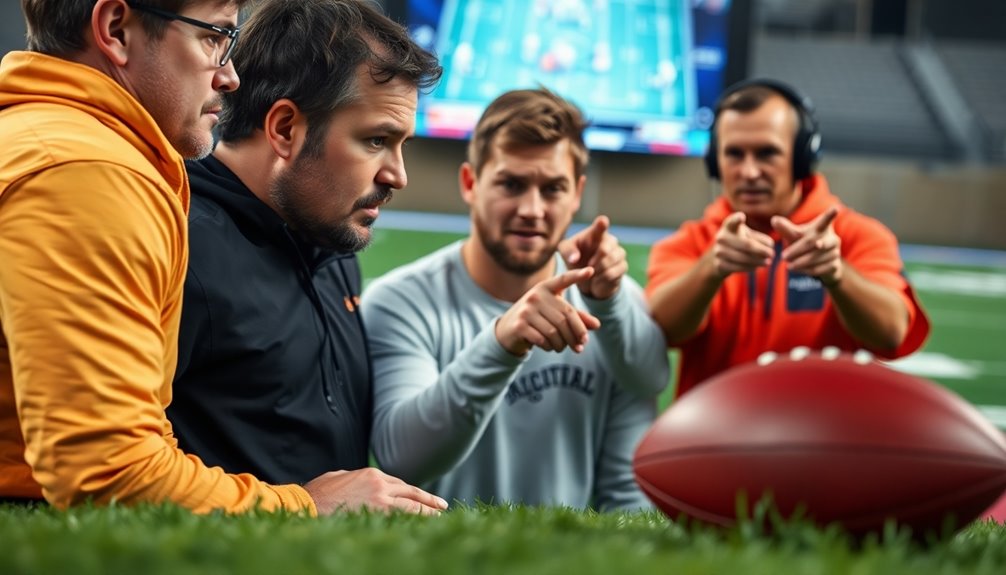
Analyzing game film is a critical component of a quarterback's preparation and development. By reviewing footage of past performances, you can greatly enhance your decision-making skills and quarterback mechanics under pressure.
Here's how to make the most of your film study:
- Identify Defensive Patterns: Look for trends in defensive formations and tendencies. This knowledge helps you anticipate plays before the snap, improving your pre-snap decision-making.
- Learn from Mistakes: Focus on instances of forced throws or poor reads. Recognizing these errors allows you to adjust and avoid repeating them in future games.
- Evaluate Timing and Connection: Study your interactions with receivers to assess timing and accuracy. This evaluation can help you make necessary adjustments, ensuring a smoother operation in high-pressure situations.
Building Quarterback Intelligence
Building your quarterback intelligence means sharpening your cognitive skills and analyzing game situations effectively.
By focusing on drills that enhance your ability to read defenses and anticipate plays, you prepare yourself for high-pressure moments.
Integrating these elements into your training can lead to smarter decision-making on the field.
Cognitive Skills Development
In today's fast-paced game, enhancing your cognitive skills is essential for any aspiring quarterback. Building quarterback intelligence (QBIQ) helps improve your cognitive performance, especially under pressure.
To excel in decision-making and situational awareness, you need to engage in targeted drills that simulate game scenarios. Here are three effective strategies:
- Quick Decision-Making Drills: Participate in 7-on-7s to practice rapid assessments of the field, improving your reaction time and awareness in real-time situations.
- Mental Preparation Techniques: Use visualization and game film analysis to reinforce your decision-making skills. This mental rehearsal helps you anticipate plays and make informed choices before they unfold on the field.
- Target Recognition and Route Adaptation: Regularly engage in drills that focus on identifying targets and adapting to changing routes. This practice sharpens your ability to evaluate options and respond wisely during gameplay.
Game Situation Analysis
Understanding game situations is vital for any quarterback looking to elevate their performance. Game situation analysis sharpens your ability to quickly assess offensive and defensive formations, greatly enhancing your decision-making under pressure. By developing a thorough grasp of these formations, you can anticipate defensive strategies, allowing for more effective play execution.
Incorporating game film analysis into your training is essential. It helps you recognize patterns and mistakes, fostering improved situational awareness during live play. As you study film, you'll learn to identify common defensive alignments and their tendencies, which prepares you for real-time scenarios.
Simulating high-pressure situations in practice, like 7-on-7 drills, cultivates your capacity to make rapid decisions while staying mindful of defensive rushes. This practice enhances your overall quarterback intelligence (QBIQ), allowing you to respond instinctively in critical moments.
Moreover, engaging in mental preparation techniques, such as visualizing successful plays, boosts your confidence and clarity. When faced with real-time decision-making challenges, you'll find that your preparation pays off, leading to better outcomes on the field.
Embrace game situation analysis, and watch your decision-making skills soar.
Essential Quarterback Drills
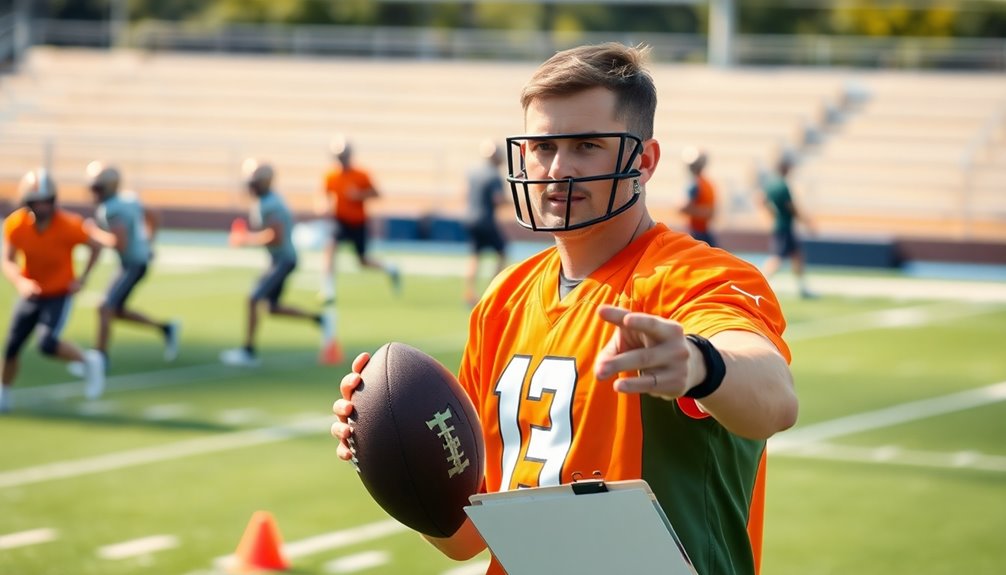
Mastering essential quarterback drills is essential for developing the skills needed to excel on the field. These drills focus on enhancing your decision-making abilities, especially under pressure. Here are three key drills to incorporate into your practice:
- Sudden Change QB Drill: This drill hones your quick footwork and decision-making as you simulate dodging pressure while keeping your eyes downfield for open receivers.
- Brady Quarterback Drill: Focused on developing your pocket movement and target identification, this drill is important for maintaining composure when facing defensive pressure.
- 7-on-7 Drills: These practice scenarios replicate game-time pressure, allowing you to make quick decisions while scanning the field for opportunities.
Incorporating these quarterback drills into your routine won't only improve your accuracy but also enhance your ability to assess multiple options rapidly.
The Ultimate Reverse QB Drill, for instance, trains you to execute a 180-degree turn, boosting your decision-making speed.
Pocket Presence Development
Pocket presence development is essential for quarterbacks who want to thrive under pressure. It's all about enhancing your awareness and ability to navigate the pocket while avoiding defenders. To build this skill, regular practice of lateral movement drills is vital. These drills improve your side-to-side agility, helping you evade rushers and create throwing lanes.
Incorporating the Brady Drill into your training sessions can greatly boost your footwork and target identification. This drill allows you to practice surveying the field while under duress, sharpening your decision-making skills in real-time.
Another effective exercise is the Sudden Change QB Drill, which simulates game situations. It forces you to react quickly to simulated pressure while keeping your eyes downfield, honing your ability to make smart decisions under stress.
Additionally, analyzing your game film is invaluable. By reviewing your pocket movement patterns and decision-making tendencies, you can pinpoint areas for improvement in high-pressure situations. This reflection helps you understand how to maintain composure when the heat is on.
Focus on these aspects, and you'll see considerable improvements in your pocket presence.
Evading Pressure Techniques
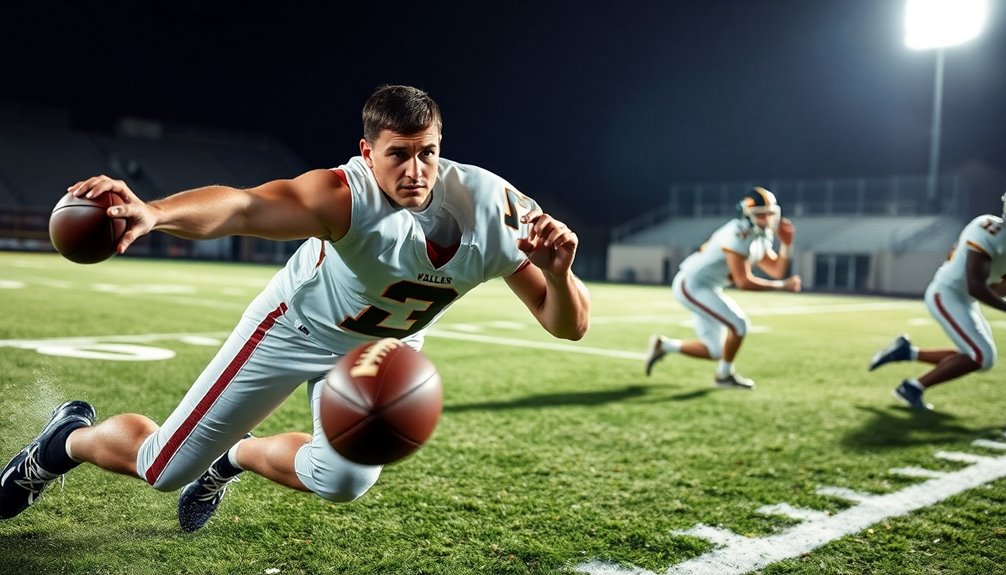
Evading pressure techniques are vital for a quarterback's ability to stay calm and make plays under pressure. By honing your agility and lateral movement, you can navigate the pocket effectively, even when under duress.
Here are three key drills to incorporate into your practice:
- Sudden Change QB Drill: This drill sharpens your ability to dodge pressure while keeping your eyes downfield. It emphasizes quick footwork shifts, ensuring you remain poised when defenders close in.
- Footwork Drills: Focus on lateral movement drills that enhance your side-to-side agility. Regular practice will help you maintain a solid base and allow for quicker reactions to defensive shifts.
- Pocket Presence Drills: These drills cultivate your awareness and improve your reaction time. By simulating defensive movements, you'll learn to assess the field and make swift decisions, even in chaotic situations.
Consistently practicing these evading pressure techniques will notably reduce your release time, allowing you to throw accurately before defenders can close in.
This skill is vital for maintaining composure and executing plays effectively under pressure.
Enhancing Throwing Accuracy
Throwing accuracy is essential for a quarterback's success on the field. To enhance your precision, consistent target practice is key. Focusing on your core and arm development through regular drills can greatly improve your throwing accuracy, especially when facing pressure.
One effective drill is the "Perfect the Quarterback Drop Drill." This drill hones your footwork and hip positioning, allowing for a more effective throwing motion and better accuracy during quick decisions.
Don't underestimate the power of a quick release. By emphasizing this technique, you can maintain accuracy even when defenders are closing in, as it minimizes their reaction time.
The "Ultimate Reverse QB Drill" is another excellent exercise that trains you to quickly identify targets while simulating game-like pressure, ensuring your throws are precise.
Lastly, practice with different receivers in varied scenarios. This enhances your timing and understanding of their routes, leading to better connections under pressure.
Endurance Training for Quarterbacks
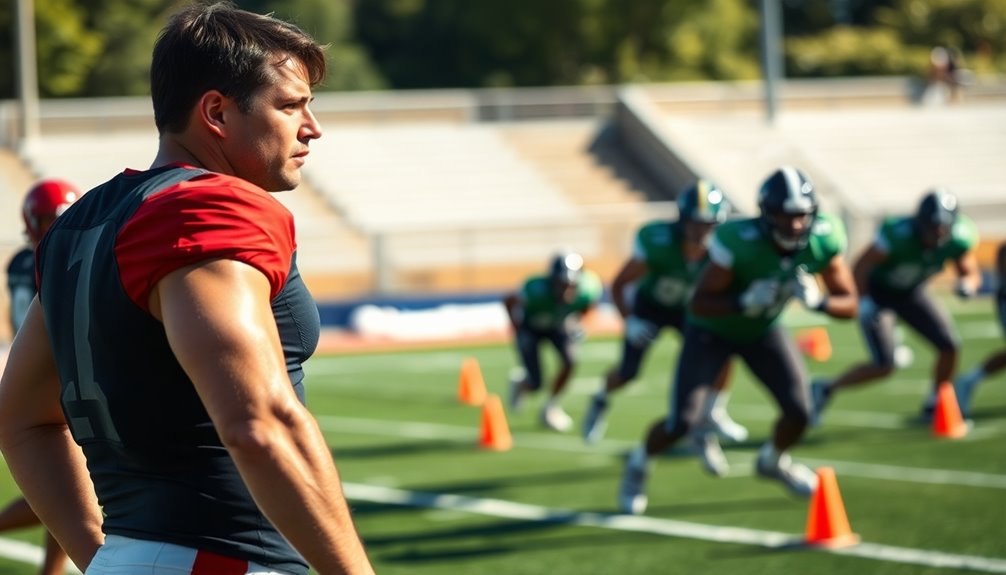
To maintain peak performance throughout the game, you need to focus on endurance training. This training isn't just about running miles; it's about enhancing your decision-making under pressure.
High school quarterbacks often struggle with fatigue late in the game, which can lead to costly mistakes. By building your stamina, you can stay sharp and responsive, even in the crunch time.
Here are three effective endurance training methods to evaluate:
- Cardiovascular Workouts: Incorporate running, swimming, or cycling into your routine. These activities boost your overall stamina, helping you evade defenders and execute plays seamlessly.
- High-Intensity Interval Training (HIIT): This approach mirrors the stop-and-start nature of football, improving both your aerobic and anaerobic capacities. It's perfect for developing the quick bursts of energy needed during a game.
- Regular Endurance Drills: Consistent training enhances your reaction times, making it easier to respond to defensive pressures and shifting game dynamics.
Specialized Training Camps
Specialized training camps frequently provide quarterbacks with the opportunity to sharpen their decision-making skills in high-pressure situations.
These camps focus on realistic, simulated game scenarios that challenge you to think quickly and react effectively. You'll engage in various QB drills designed to enhance your ability to read defenses and respond under duress, which is essential for success on the field.
Mentorship from elite quarterbacks is often a highlight of these camps. Learning from their experiences and insights can give you a significant edge in quick decision-making and play execution.
The instructors typically have professional coaching backgrounds, ensuring that you receive high-quality training relevant to today's game.
In this structured environment, you'll collaborate and compete with peers, which fosters a sense of camaraderie while pushing you to perform at your best.
The competitive atmosphere simulates defensive pressure, helping you practice making split-second decisions that can change the outcome of a game.
Role Models in Quarterbacking

In the world of quarterbacking, having role models like Tom Brady and Peyton Manning can greatly influence your development as a player.
These quarterbacks are celebrated for their exceptional decision-making skills under pressure, often leading their teams to victory. By observing their strategies, you can improve your own approach to the game.
Here are three key lessons you can learn from these role models:
- Quick Decision-Making: Brady and Manning demonstrate how to assess defensive formations rapidly, making split-second decisions that boost your team's success rate.
- Composure Under Pressure: Quarterbacks like Drew Brees show that maintaining composure can lead to higher completion percentages and better execution of plays.
- Mentorship and Influence: Attend camps led by former NFL stars to absorb their techniques and strategies.
This mentorship fosters a culture of excellence in decision-making among aspiring quarterbacks.
Conclusion
As you step onto the field, think of yourself as a chess master, facing an opponent who's always one move ahead. Each drill you practice sharpens your mind like a knight preparing for battle, ensuring you make swift, strategic decisions under pressure. Remember, every throw is a calculated risk, and every game simulation is a chance to refine your instincts. Embrace the challenge, and soon you'll navigate the chaos with the grace of a seasoned warrior, leading your team to victory.

